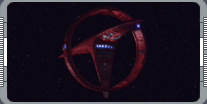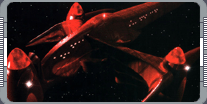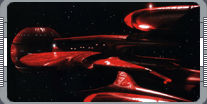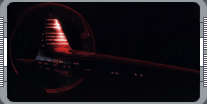
Designing the Ti'Mur - By Doug Drexler.
Enterprise's eigth episode introduced us to the first major Vulcan ship ever to appear on Star Trek. Its
designer, Doug Drexler, was determined to make it memorable, so he sought inspiration from Matt Jefferies.
 Despite a long and destinguished history in Star Trek, the Vulcans have had remarkably few ships. We didn't
see a single one in the original series, and in seven years of Star Trek: The Next Generation we glimpsed only
a solitary group of Vulcan transports. The Vulcans, however, are an essential part of Enterprise, and, since
they haven't shared all of their technology with humans, it was obvious that they would have their own ships.
And, sure enough, the script for 'Breaking the Ice' called for a Vulcan ship called the Ti'Mur. Because John
Eaves was busy working on the new movie, Star Trek: Nemesis, the task of designing the Ti'Mur fell to his
colleague, Doug Drexler.
Despite a long and destinguished history in Star Trek, the Vulcans have had remarkably few ships. We didn't
see a single one in the original series, and in seven years of Star Trek: The Next Generation we glimpsed only
a solitary group of Vulcan transports. The Vulcans, however, are an essential part of Enterprise, and, since
they haven't shared all of their technology with humans, it was obvious that they would have their own ships.
And, sure enough, the script for 'Breaking the Ice' called for a Vulcan ship called the Ti'Mur. Because John
Eaves was busy working on the new movie, Star Trek: Nemesis, the task of designing the Ti'Mur fell to his
colleague, Doug Drexler.
Drexler knows Star Trek inside out, so he was all too aware of the responsibility he was being given. "When I
was asked to come up with a design for the Vulcan ship it was a little bit daunting," he says. "After all, here
was undoubtedly one of Star Trek's most important and influential extra-terrestrial civilizations yet we knew
 very little about the Vulcans." He goes on to explain that the task was even more daunting because, in more
than 600 episodes, Star Trek had never really establised a design ethic for Vulcan ships. "Their background had
been shrouded in secrecy and antiquity and, because they had played such an important role in the original
series, Gene Roddenberry had made a conscious decision to keep them out of the limelight on The Next Generation."
Given that the new Vulcan ship was likely to make many appearances on Enterprise, Drexler says that he wanted
to be sure that it was as memorable as possible. "When you're designing ships for Star Trek it's smart to note
that the starship designs that have endured and flourished since the original series are the distinctive
Federation cruiser, like the original Enterprise, and the classic Klingon battle cruiser, both of which were
invented by original Star Trek design bard Walter 'Matt' Jefferies. "What was it that made Matt's designs so
striking and enduring? In my opinion, the answer lies in their simplicity and distinctive profile. If you look
at his sketches for the original series you can see that they are not overworked; the design is clear, and clean,
and recognizable, even when you squint your eves, or if the vessel is the size of a quarter of screen. Sometimes
ships of the week look like potatoes when seen from a distance. A hero ship for a hero race needs to pass the
squint test." Of course, Jefferies had never designed a Vulcan ship, but Drexler knew that he had developed
very little about the Vulcans." He goes on to explain that the task was even more daunting because, in more
than 600 episodes, Star Trek had never really establised a design ethic for Vulcan ships. "Their background had
been shrouded in secrecy and antiquity and, because they had played such an important role in the original
series, Gene Roddenberry had made a conscious decision to keep them out of the limelight on The Next Generation."
Given that the new Vulcan ship was likely to make many appearances on Enterprise, Drexler says that he wanted
to be sure that it was as memorable as possible. "When you're designing ships for Star Trek it's smart to note
that the starship designs that have endured and flourished since the original series are the distinctive
Federation cruiser, like the original Enterprise, and the classic Klingon battle cruiser, both of which were
invented by original Star Trek design bard Walter 'Matt' Jefferies. "What was it that made Matt's designs so
striking and enduring? In my opinion, the answer lies in their simplicity and distinctive profile. If you look
at his sketches for the original series you can see that they are not overworked; the design is clear, and clean,
and recognizable, even when you squint your eves, or if the vessel is the size of a quarter of screen. Sometimes
ships of the week look like potatoes when seen from a distance. A hero ship for a hero race needs to pass the
squint test." Of course, Jefferies had never designed a Vulcan ship, but Drexler knew that he had developed
 something that might work for hime. When Jefferies was designing the original
USS Enterprise NCC-1701 he experimented with a distinctive shape
that consisted of a long, thin ship with a large, hoop-shaped engine. Jefferies had rejected it as impractical,
but Drexler says he was intrigued by it. "In my mind, that was a classic design. It had an unmistakable
profile; it couldn't be confused with anything else. It was actually seen once as a fleeting background
portrait of a starship in Star Trek: The Motion Picture. 'All these ships were called 'Enterprise," Decker told
Ilia, which, by the way, established that there starships called 'Enterprise' apart from those on the wall in
Picard's observation lounge (critics take note). That portrait also established that Earth's starship designers
were going to flirt with a configuration that dramatically deviated from the standard saucer with nacelles.
"Enterprise had established the Vulcans as our guarded mentors. We're slightly annoyed at them, while at the
same time admiring these aloof, analytical, and strangely beautiful people. 'Ah,' I thought, as I mulled over
the Vulcan ship design question for Enterprise. 'This is the perfect place to fit the hoop ship.' "The script
stated that Trip would be ga-ga over this Surak-class starship. After laying eyes on it, there was no question
in my mind that he went to bed that night puzzling out the exotic shape. We humans would certainly have to
build one of these - if you get a minute, go on the internet
something that might work for hime. When Jefferies was designing the original
USS Enterprise NCC-1701 he experimented with a distinctive shape
that consisted of a long, thin ship with a large, hoop-shaped engine. Jefferies had rejected it as impractical,
but Drexler says he was intrigued by it. "In my mind, that was a classic design. It had an unmistakable
profile; it couldn't be confused with anything else. It was actually seen once as a fleeting background
portrait of a starship in Star Trek: The Motion Picture. 'All these ships were called 'Enterprise," Decker told
Ilia, which, by the way, established that there starships called 'Enterprise' apart from those on the wall in
Picard's observation lounge (critics take note). That portrait also established that Earth's starship designers
were going to flirt with a configuration that dramatically deviated from the standard saucer with nacelles.
"Enterprise had established the Vulcans as our guarded mentors. We're slightly annoyed at them, while at the
same time admiring these aloof, analytical, and strangely beautiful people. 'Ah,' I thought, as I mulled over
the Vulcan ship design question for Enterprise. 'This is the perfect place to fit the hoop ship.' "The script
stated that Trip would be ga-ga over this Surak-class starship. After laying eyes on it, there was no question
in my mind that he went to bed that night puzzling out the exotic shape. We humans would certainly have to
build one of these - if you get a minute, go on the internet
 and look at the Soviet space shuttle. I figure that's what happened, but obviously it was a brief flirtation,
because we ended up sticking to our very human saucer-nacelle configuration." Having decided to work with
Jefferies' design, Drexler mode some modifications to make it look more Vulcan, giving it curves and peaks that
were inspired by the Vulcan temple and clothing that were seen in Star Trek III: The Search for Spock, and John
Eaves' design for the Vulcan scout ship that appeared at the end of Star Trek: First Contact. Although Drexler
was in love with the hoop design, he wouldn't have been doing his job if he didn't provide production designer
Herman Zimmerman and executive producers Rick Berman and Brannon Braga with some alternatives. Consequently,
he would up two other designs to show them. "One echoed some of the shapes seen in the Vulcan lander; the
other foreshadowed the giant sphere of the USS Pasteur NCC-58925
which was inspired by another Matt Jefferies concept for the Enterprise that he'd labeled the USS Independence.
Needless to say, I was delighted that Rick and Brannon went for the exotic hoop and arrow, and I feel that the
Surak-class ship will enjoy a longevity if only for that certain Jefferies 'je ne sais quoi.'"
and look at the Soviet space shuttle. I figure that's what happened, but obviously it was a brief flirtation,
because we ended up sticking to our very human saucer-nacelle configuration." Having decided to work with
Jefferies' design, Drexler mode some modifications to make it look more Vulcan, giving it curves and peaks that
were inspired by the Vulcan temple and clothing that were seen in Star Trek III: The Search for Spock, and John
Eaves' design for the Vulcan scout ship that appeared at the end of Star Trek: First Contact. Although Drexler
was in love with the hoop design, he wouldn't have been doing his job if he didn't provide production designer
Herman Zimmerman and executive producers Rick Berman and Brannon Braga with some alternatives. Consequently,
he would up two other designs to show them. "One echoed some of the shapes seen in the Vulcan lander; the
other foreshadowed the giant sphere of the USS Pasteur NCC-58925
which was inspired by another Matt Jefferies concept for the Enterprise that he'd labeled the USS Independence.
Needless to say, I was delighted that Rick and Brannon went for the exotic hoop and arrow, and I feel that the
Surak-class ship will enjoy a longevity if only for that certain Jefferies 'je ne sais quoi.'"
The next stage of the process involved refining the shape of the hoop ship; Drexler started by turning out some
variations that showed it subtly different and engine pods. One change involved turning the ship upside down.
 "I just realized that it looked better defying gravity rather than hanging from the hoop,' Drexler syas, "and
Herman, Rick, and Brannon heartily endorsed that approach." The other change involved eliminating any
physical connection between the main body of the ship and the hoop, so they are actually separate elements. "We
liked the defiance of conventional structural support," Drexler explains. "It makes the Vulcans look like they
control powers beyond human ken. This was true of the original TV Enterprise. Those struts that support the
nacelles defy what we understand today. It says that these people are masters of technologies that we don't yet
understand. It speaks volumes for the technology at play." Finally, once the design was approved, Drexler's
model was shipped over to Eden FX, who put it into action in 'Breaking the Ice.' Since then, it has made
several more appearances alongside Enterprise NX-01, another ship that was directly inspired by Matt Jefferies
original designs.
"I just realized that it looked better defying gravity rather than hanging from the hoop,' Drexler syas, "and
Herman, Rick, and Brannon heartily endorsed that approach." The other change involved eliminating any
physical connection between the main body of the ship and the hoop, so they are actually separate elements. "We
liked the defiance of conventional structural support," Drexler explains. "It makes the Vulcans look like they
control powers beyond human ken. This was true of the original TV Enterprise. Those struts that support the
nacelles defy what we understand today. It says that these people are masters of technologies that we don't yet
understand. It speaks volumes for the technology at play." Finally, once the design was approved, Drexler's
model was shipped over to Eden FX, who put it into action in 'Breaking the Ice.' Since then, it has made
several more appearances alongside Enterprise NX-01, another ship that was directly inspired by Matt Jefferies
original designs.
|
|
"DESIGNING THE TI'MUR" - JULY 2002 ISSUE 39 STAR TREK: THE MAGAZINE COPYRIGHT OF PARAMOUNT PICTURES.
|